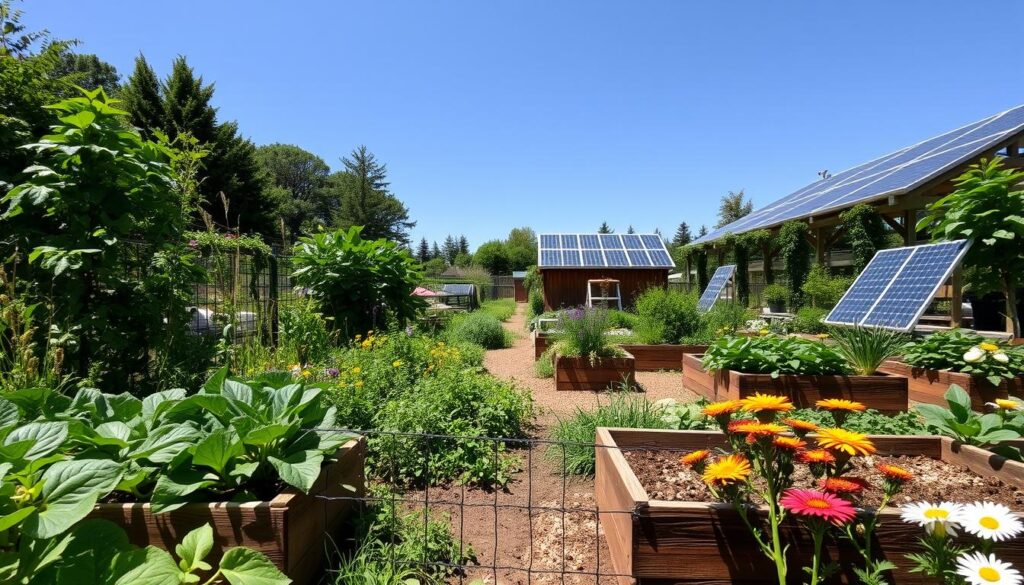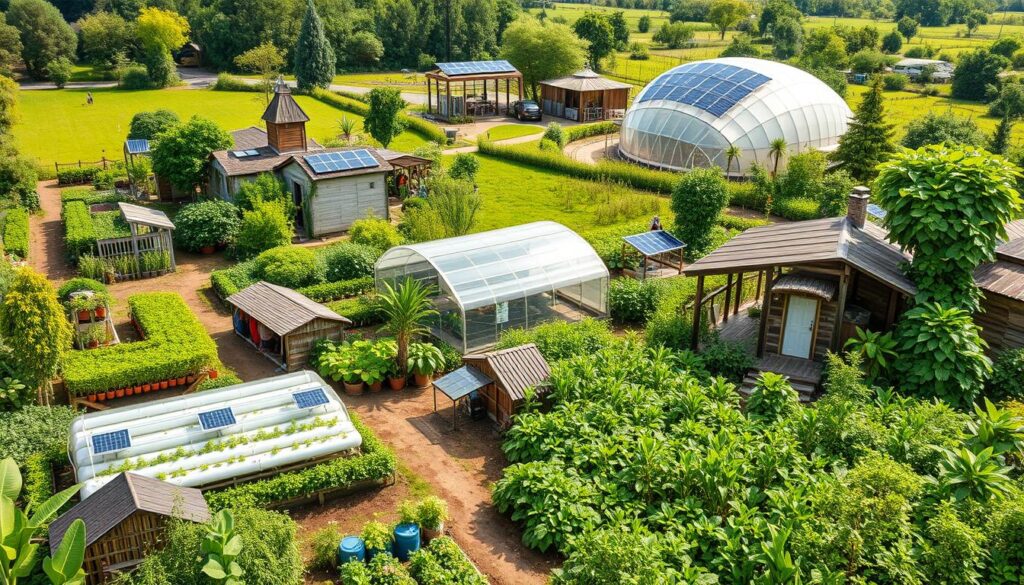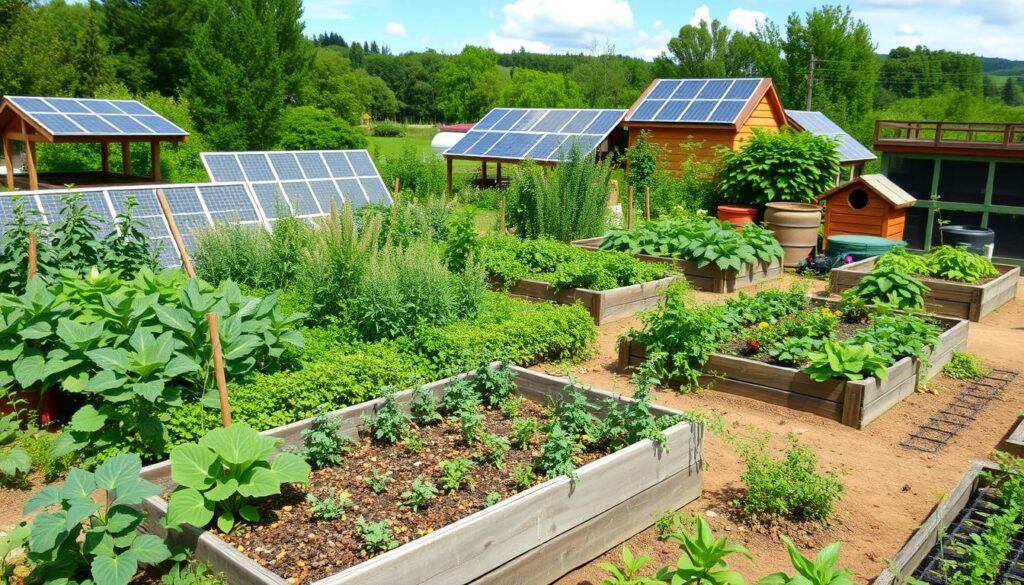Imagine businesses that grow while helping the planet. Permaculture business innovation is all about this. It makes systems sustainable and regenerative, cutting down on harm to the environment. It also boosts efficiency and profits.
Companies like Patagonia show how it works. They use permaculture in their supply chain, cutting waste and supporting green practices. This way, they work with nature to build a better future.
By adopting permaculture, businesses can use less non-renewable resources. They can manage what they use better and support renewable energy. This thinking makes businesses more circular, where everything connects and supports each other.
The Financial Permaculture Institute (FPI) says it’s key to make local businesses healthier and regenerative. This is how they make money in our current system.
Key Takeaways
- Permaculture business innovation promotes sustainable practices and regenerative entrepreneurship
- Companies can reduce environmental impact and improve efficiency by implementing permaculture principles
- Permaculture business innovation encourages a holistic approach to creating sustainable and regenerative systems
- Businesses can reduce their reliance on non-renewable resources by embracing permaculture principles
- Permaculture business innovation promotes community-driven finance and local economic development
- Companies like Patagonia have successfully implemented permaculture principles in their supply chain management
- Permaculture business innovation is essential for long-term business stability and profit generation
Understanding Permaculture Principles
Permaculture is built on three main ethics: people care, earth care, and fair share. These ethics help design sustainable systems. This is key for regenerative entrepreneurship. By using permaculture, businesses can move towards more sustainable practices. This helps them fit into ecological business models.
A good permaculture system works on its own, needing little upkeep. This shows how natural systems are efficient. It helps businesses lessen their environmental harm and get stronger against climate change.
Definition and Core Concepts
Permaculture teaches us to find solutions that work together, not separately. David Holmgren has outlined 12 permaculture principles. These apply to personal, economic, social, and political areas.
Importance of Sustainability
Sustainable actions can really help businesses connect with their stakeholders. This is vital for a business’s success. When designing for sustainability, understanding all stakeholders is key. It can prevent employee burnout and make operations more efficient.
Key Elements of Permaculture Design
Permaculture design focuses on biodiversity, using resources wisely, and reducing waste. By following these, businesses can become more reflective, innovative, and adaptable. This leads to a more sustainable future.
The Role of Innovation in Permaculture
Innovation is key in permaculture. It helps businesses keep up with environmental changes and stay competitive. By using green business solutions and sustainable development strategies, companies can find new ways to be sustainable and regenerative.
For example, using permaculture can make crops grow better and increase biodiversity. Projects like the Jajarkot Permaculture Programme and the Himalayan Permaculture Center show success. They use community training and work with households to promote permaculture.

- Enhanced crop production and biodiversity
- Improved social, environmental, and economic advantages
- Increased efficiency in resource use
- Reduced operational costs through renewable energy integration and natural building techniques
By adopting permaculture and innovation, businesses can help create a sustainable future. This benefits the environment and improves our quality of life.
Identifying Market Needs
To succeed in eco-friendly entrepreneurship, understanding market needs is key. Designing sustainable solutions that meet customer needs is crucial. This involves conducting market research, analyzing competitors, and engaging with local communities.
By doing this, businesses can spot opportunities and create innovative solutions. These solutions promote sustainable agriculture business practices.
Some key areas to focus on include:
- Conducting market research to understand customer needs and preferences
- Analyzing competitor strategies to identify gaps in the market
- Engaging with local communities to build relationships and create mutually beneficial solutions
By taking a holistic approach to market research and analysis, businesses can understand the market better. They can then create solutions that meet customer needs while promoting sustainable agriculture business practices. This might include offering organic and sustainable food, reducing waste and emissions, and encouraging eco-friendly practices in the supply chain.
| Market Need | Solution |
|---|---|
| Increasing demand for organic food | Offering sustainable and organic food options |
| Reducing waste and carbon emissions | Implementing eco-friendly practices throughout the supply chain |
Innovative Business Models
Businesses are now focusing more on green innovation in business strategies. This shift highlights the need for sustainable management models. By using permaculture principles, companies can create more sustainable systems. This helps build an environmentally conscious economy.
For example, permaculture practice stresses the importance of drought-proofing and water conservation. These goals can be met through new business models.
Here are some examples of innovative business models:
- Community Supported Agriculture (CSA) programs, which connect consumers directly with local farmers
- Subscription-based models, offering customers regular deliveries of fresh produce
- Agro-tourism opportunities, allowing visitors to experience and learn about sustainable farming practices

By adopting permaculture business innovation, companies can lower their environmental impact. They can also find new ways to make money and improve their reputation. As more people look for sustainable products, businesses that use innovative practices will do well.
Integrating Technology in Permaculture
The world is moving towards more sustainable and regenerative practices. Technology plays a key role in permaculture, making systems more efficient and sustainable. This helps in sustainable business practices. Tools like drones, soil sensors, and IoT applications are enhancing permaculture.
About 60% of farmers want to use more technology in their work. This desire is driven by the need for better efficiency and productivity. Companies like FarmBot are at the forefront with automated systems. These systems can cut water use by up to 90% through precise irrigation.
Benefits of Technology in Permaculture
- Increased crop yields: up to 20% compared to conventional farming methods
- Improved water management: reduction in water usage by up to 50%
- Enhanced biodiversity: permaculture systems can increase biodiversity by 50% compared to monoculture farming systems
By using technology and sustainable business practices, permaculture practitioners can improve their work. They also help the agricultural industry move towards regenerative entrepreneurship. As the sector grows, we’ll see more tech innovations in permaculture, leading to growth and sustainability.
Sustainable Supply Chain Management
Businesses need to adopt sustainable supply chain management to reduce environmental impact. This approach helps in using green business solutions. By choosing local materials, companies can cut down their carbon footprint and help local economies.
It’s also important to reduce waste and use eco-friendly practices. Companies like Patagonia have started recycling programs and sustainable manufacturing. Working with local businesses can make these efforts even stronger, showing a team effort towards sustainability.

Benefits of Sustainable Supply Chain Management
- Reduced carbon footprint through local sourcing
- Increased use of recycled materials
- Improved brand reputation through commitment to sustainability
- Enhanced partnerships with local businesses and communities
By using sustainable supply chain practices, businesses can help create a better future. They align with ecological business models and green solutions.
| Practice | Environmental Impact Reduction | Economic Benefit |
|---|---|---|
| Local Sourcing | 20-30% | 10-15% cost savings |
| Recycling Programs | 30-40% | 5-10% cost savings |
| Partnerships with Local Businesses | 15-25% | 5-10% increase in brand reputation |
Financial Strategies for Growth
Using sustainable development strategies is key for permaculture businesses to grow. This means using eco-friendly entrepreneurship to help the planet and keep finances stable. The Global Footprint Network says we use more energy than we make, showing we need to be green in our money matters.
Getting grants and funding is a big part of planning finances for permaculture. Groups like the Financial Permaculture Institute help with money and learning. They have plans to help businesses grow, teach new ones, and even talk about new money ideas. For more on permaculture and money, check out rich and resilient living or permaculture practice for budget tips.
Some important money tips for permaculture businesses are:
- Use less of the earth’s resources
- Make buildings and use energy wisely
- Get along well with the community
- Use things over and over again
By following these tips, permaculture businesses can grow while being kind to the earth.
| Strategy | Benefits |
|---|---|
| Reducing reliance on non-renewable resources | Less harm to the environment, saves money |
| Implementing energy-efficient practices and building designs | Uses less energy, cuts costs |
| Building beneficial relationships with the community | Keeps customers coming back, gets more support |
Marketing and Branding Innovations
For a sustainable agriculture business, it’s key to have good marketing and branding. Using permaculture, companies can build a brand that speaks to those who care about the environment. For example, Patagonia has made a name for itself by focusing on sustainability. This shows that businesses can do well while being eco-friendly.
Some important marketing and branding strategies include:
- Creating a brand that shows what the company stands for
- Being active on social media to talk to customers and show off products
- Telling stories to share the company’s message and values
By going green and using sustainable practices, companies can stand out. They’ll attract customers who also care about the planet. As more people look for eco-friendly products, businesses that focus on the environment will do well.

By using permaculture in their marketing, businesses can offer something unique. This can help them connect better with customers and build a loyal fan base.
| Marketing Strategy | Permaculture Principle |
|---|---|
| Building a strong brand identity | Care of the earth |
| Utilizing social media effectively | Care of people |
| Using storytelling in marketing | Fair share |
Collaborating with Other Innovators
Collaboration is crucial in permaculture business innovation. It helps businesses create more sustainable systems. By teaming up, they can share knowledge and resources. This leads to innovative solutions that support sustainability and regenerative practices.
Studies show that adopting sustainable practices can cut operational costs by 20-30%. Also, focusing on employee well-being boosts satisfaction and retention by 40%. This shows the value of sustainable business practices for lasting success.
Here are some ways to work with other innovators:
- Joining permaculture networks to connect with like-minded businesses and individuals
- Participating in workshops and events to share knowledge and learn from others
- Leveraging crowdsourcing ideas to tap into the collective creativity of the community
By teaming up, businesses can create something more powerful. This leads to new, sustainable products, services, and systems. These are more resilient and beneficial for the environment.
Education and Training for Innovation
Education and training are key to boosting regenerative entrepreneurship and green business models. They help businesses grow a culture of innovation and care for the planet. The Permaculture Education Institute, for example, offers courses leading to well-known certificates.
These courses mix Sustainable Business, Forestry, and Human-Centered Design. This mix helps people understand how to apply ecological principles in business. It lets them come up with new ways to support green business and entrepreneurship.
Some key features of these programs include:
- Interdisciplinary approach, combining Sustainable Business, Forestry, and Human-Centered Design
- Focus on regenerative entrepreneurship and ecological business models
- Internationally-recognized certificates, such as the Permaculture Design Certificate and Permaculture Teacher Certificate
By investing in education and training, businesses can support sustainability and regenerative practices. This leads to new solutions that help both the business and the environment. As more people look for green business models, the role of education and training will grow even more.
Measuring Success and Impact
To check if their green efforts are working, businesses use green business solutions and track important metrics. This helps them see how they’re doing and make better choices for the planet. It’s all about using data to improve their sustainable development strategies.
Some interesting facts are:
- Companies that focus on being green keep more customers.
- Going green can cut down on costs by 15%.
- Businesses that go for sustainable development strategies see happier employees and better retention.
By using green business solutions and keeping an eye on their results, companies can build a culture of sustainability. David Holmgren’s 12 principles of permaculture can guide businesses towards being more regenerative and strong.
Scaling Your Permaculture Business
As a permaculture business grows, it’s key to think about how to grow sustainably. You might want to add new products or explore franchising. This supports eco-friendly entrepreneurship and helps your sustainable agriculture business thrive.
To grow, focus on sustainable growth. You could make more products, like jams, honey, and crafts. This way, you’re not just relying on one thing. It makes your business stronger against market changes.
Strategies for Sustainable Growth
- Expand product lines to include value-added products
- Develop strategic partnerships with other businesses and organizations
- Invest in employee training and development to improve efficiency and productivity
Franchising Opportunities
Franchising is a good way for permaculture businesses to grow. It lets you reach more people while keeping your focus on eco-friendly entrepreneurship and sustainable agriculture business.
| Franchising Model | Benefits |
|---|---|
| Business Format Franchising | Provides a proven business model and ongoing support |
| Product Distribution Franchising | Allows for the distribution of products through a network of franchisees |
Future Trends in Permaculture Innovation
The global agriculture net market is set to hit over $1 billion by 2020. It’s expected to grow at a CAGR of 5% until 2030. This growth is good news for permaculture businesses.
New trends like the Circular Economy and Doughnut Economy are on the rise. They align with the Sustainable Development Goals. This means more businesses will focus on green innovation.
Permaculture’s core principles will keep guiding businesses. These include “Obtain a Yield,” “Use Small and Slow Solutions,” and “Use and Value Diversity.” These principles will help create innovative and strong business models.
Technologies like agroforestry, aquaponics, companion planting, Keyline Design, Holistic Management, rainwater harvesting, natural building, and perennial cropping will play a big role. They will help permaculture businesses grow, reduce harm to the environment, and make a positive impact on society.
As policy and regulatory landscapes change to support sustainability, permaculture innovators will have great chances to grow. They will help shape the future of agriculture and land management.

